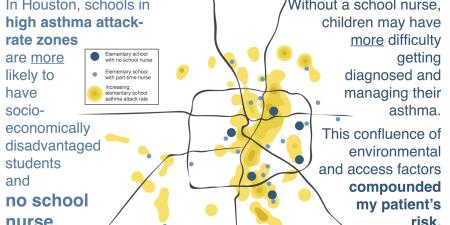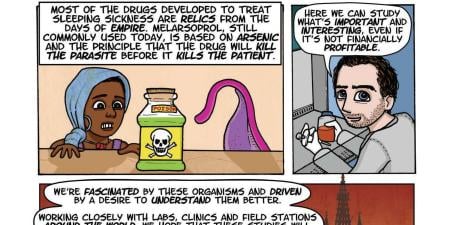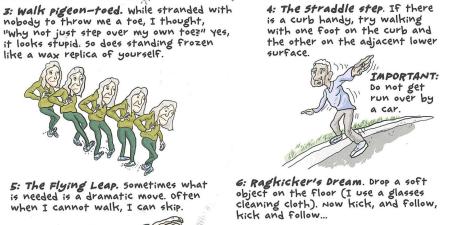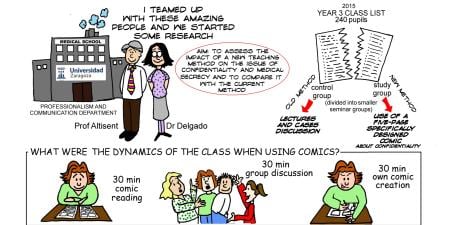Abstract
A comic created by a medical student allows the reader to share the student’s own unique perception of the medical education experience. Through the process of comic creation, medical students have opportunities to gain insight into how their relationships with patients and supervising physicians have shaped the physician they will become. The comic itself can be a safe space for expression and provides an opportunity for students and educators to share experiences.
Case
Dr. Charles, who has a busy schedule in clinic today, is seeing his long-time patient Mrs. Chapman. Mrs. Chapman has come in several times in the past for concerns about left-sided chest pain. He had previously attributed her complaints to anxiety.
As depicted in the comic below, created and illustrated by the author when he was a fourth-year medical student, Dr. Charles flippantly dismisses Mrs. Chapman’s concerns. A third-year medical student who is shadowing Dr. Charles attempts to question his quick judgment. This inquiry is met with harsh belittling of the medical student. The student is shocked by this reproach but abandons his line of questioning into the management of Mrs. Chapman’s chest pain.
Figure. A Ghost of an Idea
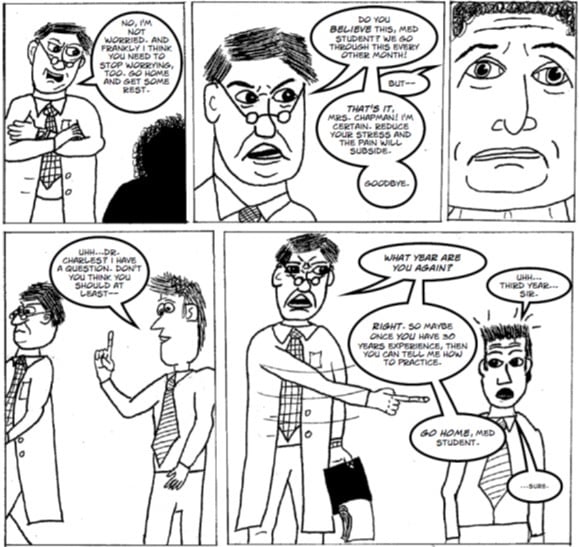
© Jeffrey Monk. Reprinted by permission of Jeffrey Monk.
Commentary
As a fourth-year medical student, I was fortunate enough to participate in the graphic medicine humanities elective offered by Michael Green at Penn State College of Medicine. This course was designed to use graphic texts to enrich the medical education experience. The medical students read and discussed multiple “graphic pathographies,” comics intended to share authors’ own experience with disease, or perhaps the illness of a loved one, and their journey navigating the health care system [1]. Books such as Stitches: A Memoir [2], Tangles: A Story about Alzheimer’s, My Mother, and Me [3], and Swallow Me Whole [4] allowed the students to reflect critically on topics such as empathy for patients and how sickness affects the experiences of patients and their families. Green and illustrator Ray Rieck also instructed students on the practical aspects of comic creation. Green’s own example of graphic medicine, “Missed It,” was used as a case study for how physicians can use comics as a tool to reflect on their own experiences during medical training and pass on valuable lessons to others in the medical profession [5]. By the end of the course, the students had studied the methods of comic creation, analyzed graphic medicine comics created by both patients and physicians, and applied that knowledge to create a comic informed by their own experiences with disease and the health care system.
In the following sections, the comic I created will be used as a case study to explore how graphic medicine can be used to represent a medical student’s perception of an interaction between his mentor clinician and a patient. In particular, the comic will be used to discuss ethical issues of the medical hierarchy and the place of medical students therein, as well as the potential loss of identity that may be experienced by students during medical school. Finally, the benefits of including medical students in the process of creating graphic pathographies will be discussed.
Origins of “Ghost of an Idea”
Panels A through E of figure 1 are excerpted from the comic, “A Ghost of an Idea,” which I wrote and drew for Green’s course [6]. The comic follows a storyline that mirrors Charles Dickens’s “A Christmas Carol,” with Dr. Charles playing the role of Ebenezer Scrooge. Dr. Charles is not a real person, but his dismissive behavior and poor conduct are based upon real people. I interacted with one physician in particular during my medical school years who, unknowingly, served as a valuable example of how not to listen to the patient and how not to appropriately address the patient’s concerns.
Using the Comics Medium to Show and Tell the Reader
Dr. Charles feels comfortable in his role as The Attending Physician: he has accrued decades of experience as a physician and thus appears to feel his opinions must be infallible. We see in figure 1, panel A, how he makes the mistake of diagnosing his patient before even stepping into her room. He feels so sure he can deduce, based on past experiences, exactly what is ailing Mrs. Chapman that he intentionally foregoes any mote of proper history-taking or physical examination. The unnamed medical student is forced to sit by idly, absorbing this exchange between physician and patient. The word balloons in figure 1, panel B, visually represent the conversation overheard by the medical student: as Dr. Charles cuts off Mrs. Chapman’s plea for understanding, so, too, does the speech bubble issuing forth from Dr. Charles’s mouth overshadow the small, abruptly silenced word balloon originating from Mrs. Chapman. The medical student continues to observe this interaction. The perspective shifts in panel C of figure 1 to the dismayed look of disappointment in a close-up shot of Mrs. Chapman’s face. There is no text in this panel, only the image of her face, possibly seen through the eyes of the medical student witnessing the results of Dr. Charles’s behavior: her concern was not heard. In addition to her reason for coming to the office being dismissed, she was belittled by Dr. Charles, who complained to the medical student about her “frequent flyer” status as a patient in his office.
The art in these first three panels lets me show my perspective of this event: I was the fly-on-the-wall medical student, shadowing my supervisor but absorbing the details of the interaction between physician and patient. Representing this type of patient interaction graphically affords learners an opportunity to witness patient maltreatment in a safe, ethical manner in which no patient is actually harmed.
Analysis of the Case
To analyze the case, I will use Green et al’s article, “The Comics Revealing Medical School’s Hidden Flaws and Hard Lessons,” which identified the themes that have been most often present in the comics written and illustrated by medical students [7]. Two themes the authors identified are on display in the panels shown in figure 1 and discussed below.
Medical hierarchy. First, the hierarchy of medicine generally places the attending physician squarely at the top and the medical student firmly at the bottom. This is not a topic that is covered during medical school orientation, yet each medical student, particularly during third-year clinical rotations, quickly learns his or her place within this assumed hierarchy. A primary objective for the medical student is to listen and learn from those members of the medical team perched on the higher rungs of the medicine ladder, even if their behavior contravenes what is explicitly taught in the curriculum. Behaviors are one part of the hidden curriculum of medical school: the cultural milieu encompassing the student as he becomes integrated into the health care team [8]. The medical student in this case should strive to apply the concepts he has already learned and question the reasoning and decision making of his superiors. Decisions about diagnosis and treatment should be evidence based, morally and ethically sound, free of bias, and respectful of patient autonomy.
Panels D and E of figure 1 demonstrate this role of the medical student. The medical student recognizes that Dr. Charles has not followed the standard of care by taking a proper history and physically examining Mrs. Chapman before proclaiming his diagnosis. The student attempts calling this misstep into question, but in panel E he is quickly reprimanded by Dr. Charles, who first confirms the student’s status: yes, he is a third-year medical student, so he is at the very nadir of the medical hierarchy. Dr. Charles not only dismisses the student’s question, but also physically dismisses the student to prevent any further inquiry into his own authority and experience.
Loss of identity. Another theme identified by Green et al. [7] and represented in the comic concerns the loss of identity and individualism that can occur during medical school. In addition to the example provided by my comic, other comics created by medical students for Green’s course feature the generic appellation “med student.” From the student authors’ point of view, the use of this term is intended to show how students are deidentified and interchangeable in the eyes of their superiors. Dr. Charles probably does not know the medical student’s name, and, as far as he is concerned, he probably does not need to. As seen in panels B and E of figure 1, Dr. Charles only refers to his mentee as “med student.” The young man who was likely assigned to work with and learn from Dr. Charles is just another anonymous med student to him. When Dr. Charles sends away his learner, he proclaims, “Go home, med student.” The scene ends there, with a look of shock and awe on the medical student’s face as he accepts this rebuke from his supposed mentor. The immediate consequence of Dr. Charles’s harsh treatment of the medical student in panel E of figure 1 is left in the gutters: the empty space between comic panels where the reader fills in the missing details.
A student in that situation is more than likely going to be less forthcoming with questions for the remainder of his clinical rotation. Some students might experience anxiety related to even working, speaking, or listening to an attending physician like Dr. Charles, and their educational experience could suffer as a result. For example, a national survey of third-year medical students conducted in 2011 found that the majority of respondents reported at least one incident of mistreatment by faculty or residents since they began their clinical rotations [9]. A smaller subset of students also reported recurrent mistreatment by faculty or residents, and these students were more likely to have higher burnout than students who reported no or infrequent mistreatment [9]. Although the survey did not define or give examples of “mistreatment,” mistreatment could be defined in a variety of ways, including racial or gender discrimination, physical intimidation, or humiliation or belittlement (as in the case presented in figure 1).
The Benefits of Incorporating Graphic Medicine into Medical Education
The students in Michael Green’s humanities course at Penn State College of Medicine—including me—benefited greatly by going through the process of creating a comic from start to finish. The process involved first brainstorming ideas for the comic, which allowed each student to reflect on his or her medical experiences thus far not only as a medical student but also as a patient or family member of someone who had a meaningful encounter with the medical system. The graphic pathographies read and analyzed for the course served as vital guides for how to approach this introspection. What were the difficulties encountered while navigating the health care system? How did it feel to participate in patient care, to heal and to serve others? How did it feel to witness loss due to disease or a medical error? The students discussed their ideas for comic concepts, which encouraged dialogue regarding what experiences, whether positive or negative, they felt were valuable components of their medical education. Experiences like those illustrated and discussed above were shared and analyzed among the group of students.
A topic that would have been awkward or intimidating to discuss with the attending faculty during a clinical rotation could be safely presented for others to explore through the student-created comic. For most students, the comic art is crude; after all, it is a medical school course, not art school, but the simplified art can help preserve the anonymity of the people presented in the comics. I was able to present Dr. Charles as a generic, middle-age male attending physician and the medical student as an equally generic young male. These comic characters represent real people to me, but anyone else can read and view the comic and understand the relationship between the characters without any blame or scorn being directed at a specific individual. This expressive characteristic is not unique to the comics medium, of course. Students can also compose written stories to express their experiences during medical school, but in that case the story is ultimately left up to the reader’s interpretation of it. Comics are different. The burden lies with the artist to visually tell the story, but the combination of pictures and words is complete and will show the reader exactly the story the author intends.
Conclusion
Using comics in medical education serves a dual function. It is a safe method of expression for a medical student. In this case, it was a way for me to convey my interpretation of the poor patient care I witnessed and my frustration with the way I was mistreated by a mentor. Comics also serve as an educational tool. The comic presented here can be used to show other students an example of a negative physician-patient interaction and encourage students to discuss other ways Dr. Charles could have handled the situation with a more patient-centered approach. The representation of the medical student in the comic could also serve as a starting point for discussion by students regarding their own mistreatment during their medical training. Comics are a powerful educational tool, and it is my hope that many more classes of fourth-year medical students at Penn State College of Medicine—and hopefully students at many more medical campuses—get the opportunity to read, discuss, and create graphic pathographies.
References
-
Green MJ, Myers KR. Graphic medicine: use of comics in medical education and patient care. BMJ. 2010;340:c863. http://www.bmj.com/content/340/bmj.c863.long. Accessed October 11, 2017.
-
Small D. Stitches: A Memoir. New York, NY: W.W. Norton; 2009.
-
Leavitt S. Tangles: A Story about Alzheimer’s, My Mother, and Me. Calgary, Alberta, Canada: Freehand Books; 2010.
-
Powell N. Swallow Me Whole. Marietta, GA: Top Shelf Productions; 2008.
- Green MJ, Rieck R. Missed It. Ann Intern Med. 2013;158(5)(pt 1):357-361.
-
Monk J. A ghost of an idea. Penn State Collection of Graphic Narratives. https://sites.psu.edu/graphicnarratives/files/2016/08/JMonk-snjl05.pdf. Published August 1, 2016. Accessed December 10, 2017.
-
Green M, Myers K, George DR. The comics revealing medical school’s hidden flaws and hard lessons. Atlantic. March 24, 2017. https://www.theatlantic.com/health/archive/2017/03/medical-humanities/520623/. Accessed October 3, 2017.
- Hafferty FW, Franks R. The hidden curriculum, ethics teaching, and the structure of medical education. Acad Med. 1994;69(11):861-871.
- Cook AF, Arora VM, Rasinski KA, Curlin FA, Yoon JD. The prevalence of medical student mistreatment and its association with burnout. Acad Med. 2014;89(5):749-754.
